A Two-Stage Robust Optimization Microgrid Model Considering Carbon Trading and Demand Response
Abstract
:1. Introduction
- (1)
- The collaborative operation optimization framework of a distributed energy power system including gas turbines, photovoltaic power generation and energy storage equipment is constructed. Optimal scheduling aims to minimize the operational costs of the microgrid.
- (2)
- The CET mechanism is implemented to restrict the carbon emissions of the microgrid, encourage the production of renewable energy sources, and curtail the production of high-carbon emission sources. It aims to enhance carbon efficiency while maintaining economic viability.
- (3)
- By introducing DR management to reduce load fluctuations, electric vehicles are used as mobile energy storage units in the microgrid to provide reliable power and stability for the microgrid during peak hours.
- (4)
- Considering the inherent unpredictability of renewable energy sources and power demand, an uncertainty set is created based on the spatial and temporal correlation between past data and uncertain parameters. To mitigate the potential impact of inaccurate renewable energy forecasts on the power grid, a two-stage stochastic robust optimization approach is employed, ensuring the secure and sustainable operation of the system.
2. The Microgrid Operation Framework Considering Carbon-Trading Mechanism and Demand Response
2.1. System Operation Framework
2.2. Carbon Emission Trading Mechanism
2.3. Demand Response Mechanism
2.4. Micro-Gas Turbine
2.5. Renewable Energy Units
2.6. Energy Storage System
2.7. Grid Interactive System
3. Two-Stage Robust Optimization Model of Microgrid
3.1. Two-Stage Robust Optimization Model
3.2. Column Constraint Generation Algorithm
- (1)
- Prediction of renewable energy output and user energy load uncertainty set U.
- (2)
- Define the lower bound , the upper bound , number of iterations , convergence threshold .
- (3)
- Take the predicted value of the uncertainty set as the initial scenario and bring it into the main problem Equation (39).
- (4)
- The optimal solution for the initial deterministic model has been attained, and the lower bound of the operating cost is updated.
- (5)
- Substituting into the subproblem Equation (41), the objective function value A and the corresponding uncertain variable A of the subproblem are solved, and the upper bound is updated.
- (6)
- Judging , if it is established, the iteration is stopped and the optimal solution is returned; otherwise, add the constraint to the main problem and run step 3 until the algorithm converges to the threshold .
4. Results and Discussion
4.1. Parameters
4.2. Analysis of Scheduling Results
4.3. Analysis of Carbon Trading Mechanism
4.4. Analysis of Demand Response Mechanism
4.5. Uncertainty Analysis
5. Conclusions
- (1)
- Considering the uncertainty of distributed generation, this paper flexibly adjusts the conservatism of microgrid optimization work through a two-stage robust optimization model. The approach results in a scheduling strategy that ensures the lowest system operation cost under unfavorable conditions, facilitating the rational allocation and utilization of resources and enhancing the economic and operational stability of the microgrid.
- (2)
- Based on the carbon-trading mechanism, this paper effectively coordinates the economy and low carbon of microgrid operations. By comparing the impact of CET price on the optimal operation results, it concludes that the system’s total operating expenses increase as the CET rate rises, while carbon emissions gradually decrease in response to changes in the carbon exchange price. Additionally, implementing a suitable carbon exchange pricing system can align low-carbon initiatives with economic goals.
- (3)
- This paper introduces an energy storage system and demand–response mechanism that can greatly reduce operating costs. When operating under a time-of-use electricity pricing mechanism, the microgrid scheduling plan of the microgrid relies on the peak–valley electricity price differential and the expenses associated with charging and discharging the energy storage unit. By implementing an energy storage system, both the cost of wasted electricity and the cost of purchased electricity can be reduced. By storing surplus photovoltaic power during periods of low demand and releasing it during peak periods, more advantages can be gained.
Author Contributions
Funding
Institutional Review Board Statement
Informed Consent Statement
Data Availability Statement
Conflicts of Interest
References
- Dong, L.; Miao, G.; Wen, W. China’s carbon neutrality policy: Objectives, impacts and paths. East Asian Policy 2021, 13, 5–18. [Google Scholar] [CrossRef]
- Hu, Y.; Chi, Y.; Zhou, W.; Wang, Z.; Yuan, Y.; Li, R. Research on energy structure optimization and carbon emission reduction path in Beijing under the Dual Carbon Target. Energies 2022, 15, 5954. [Google Scholar] [CrossRef]
- Ma, M.; Cai, W.; Cai, W. Carbon abatement in China’s commercial building sector: A bottom-up measurement model based on Kaya-LMDI methods. Energy 2018, 165, 350–368. [Google Scholar] [CrossRef]
- Zhang, X.P.; Cheng, X.M. Energy consumption, carbon emissions, and economic growth in China. Ecol. Econ. 2019, 68, 2706–2712. [Google Scholar] [CrossRef]
- Wang, Y.; Qiu, J.; Tao, Y.; Zhao, J. Carbon-oriented operational planning in coupled electricity and emission trading markets. IEEE Trans. Power Syst. 2020, 35, 3154–3157. [Google Scholar] [CrossRef]
- Li, J.; Mao, T.; Huang, G.; Zhao, W.; Wang, T. Research on Day-Ahead Optimal Scheduling Considering Carbon Emission Allowance and Carbon Trading. Sustainability 2023, 15, 6108. [Google Scholar] [CrossRef]
- Cui, Y.; Zeng, P.; Zhong, W.; Cui, W.; Zhao, Y. Low-carbon economie dispatch of electricity-gas-heat integrated energy system based on ladder-type carbon trading. Electr. Power Autom. Equip. 2021, 41, 10–17. [Google Scholar]
- Akulker, H.; Aydin, E. Optimal design and operation of a multi-energy microgrid using mixed-integer nonlinear programming: Impact of carbon cap and trade system and taxing on equipment selections. Appl. Energy 2023, 330, 120313. [Google Scholar] [CrossRef]
- Yan, L.; Zhao, Y.; Xue, T.; Ma, N.; Li, Z.; Yan, Z. Two-Layer Optimal Operation of AC–DC Hybrid Microgrid Considering Carbon Emissions Trading in Multiple Scenarios. Sustainability 2022, 14, 10524. [Google Scholar] [CrossRef]
- Zhou, Q.; Zhang, J.; Gao, P.; Zhang, R.; Liu, L.; Wang, S.; Cheng, L.; Wang, W.; Yang, S. Two-Stage Robust Optimization for Prosumers Considering Uncertainties from Sustainable Energy of Wind Power Generation and Load Demand Based on Nested C&CG Algorithm. Sustainability 2023, 15, 9769. [Google Scholar]
- Saeed, M.H.; Wang, F.Z.; Kalwar, B.A.; Iqbal, S. A Review on Microgrids’ Challenges & Perspectives. IEEE Access 2021, 9, 166502–166517. [Google Scholar]
- Yaqoob, M.; Lashab, A.; Vasquez, J.C.; Guerrero, J.M.; Orchard, M.E.; Bintoudi, A.D. A Comprehensive Review on Small Satellite Microgrids. IEEE Trans. Power Electron. 2022, 37, 12741–12762. [Google Scholar] [CrossRef]
- Khan, A.A.; Naeem, M.; Iqbal, M.; Qaisar, S.; Anpalagan, A. A compendium of optimization objectives, constraints, tools and algorithms for energy management in microgrids. Renew. Sustain. Energy Rev. 2016, 58, 1664–1683. [Google Scholar] [CrossRef]
- Bahramara, S.; Sheikhahmadi, P.; Golpîra, H. Co-optimization of energy and reserve in standalone micro-grid considering uncertainties. Energy 2019, 176, 792–804. [Google Scholar] [CrossRef]
- Hadayeghparast, S.; Farsangi, A.S.; Shayanfar, H. Day-ahead stochastic multi-objective economic/emission operational scheduling of a large scale virtual power plant. Energy 2019, 172, 630–646. [Google Scholar] [CrossRef]
- Kong, X.; Liu, D.; Wang, C.; Sun, F.; Li, S. Optimal operation strategy for interconnected microgrids in market environment considering uncertainty. Appl. Energy 2020, 275, 115336. [Google Scholar] [CrossRef]
- Cao, B.; Dong, W.; Lv, Z.; Gu, Y.; Singh, S.; Kumar, P. Hybrid Microgrid Many-Objective Sizing Optimization With Fuzzy Decision. IEEE Trans. Fuzzy Syst. 2020, 28, 2702–2710. [Google Scholar] [CrossRef]
- Jiang, J.; Zhang, L.; Wen, X.; Valipour, E.; Nojavan, S. Risk-based performance of power-to-gas storage technology integrated with energy hub system regarding downside risk constrained approach. Int. J. Hydrog. Energy 2022, 47, 39429–39442. [Google Scholar] [CrossRef]
- Zheng, S.; Shahzad, M.; Asif, H.M.; Gao, J.; Muqeet, H.A. Advanced optimizer for maximum power point tracking of photovoltaic systems in smart grid: A roadmap towards clean energy tech-nologies. Renew. Energy 2023, 206, 1326–1335. [Google Scholar] [CrossRef]
- Deng, W.; Zhang, Y.; Tang, Y.; Li, Q.; Yi, Y. A neural network-based adaptive pow-er-sharing strategy for hybrid frame inverters in a microgrid. Front. Energy Res. 2023, 10, 1082948. [Google Scholar] [CrossRef]
- Dong, J.; Yang, P.; Nie, S. Day-Ahead Scheduling Model of the Distributed Small Hydro-Wind-Energy Storage Power System Based on Two-Stage Stochastic Robust Optimization. Sustainability 2019, 11, 2829. [Google Scholar] [CrossRef]
- Naji Alhasnawi, B.; Jasim, B.H.; Esteban, M.D. A New Robust Energy Management and Control Strategy for a Hybrid Microgrid System Based on Green Energy. Sustainability 2020, 12, 5724. [Google Scholar] [CrossRef]
- Lotfi Akbarabadi, M.; Sirjani, R. Achieving Sustainability and Cost-Effectiveness in Power Generation: Multi-Objective Dispatch of Solar, Wind, and Hydro Units. Sustainability 2023, 15, 2407. [Google Scholar] [CrossRef]
- Wang, X.; Zhao, H.; Xie, G.; Lin, K.; Hong, J. Research on Industrial and Commercial User-Side Energy Storage Planning Considering Uncertainty and Multi-Market Joint Operation. Sustainability 2023, 15, 1828. [Google Scholar] [CrossRef]
- Li, Q.; Li, Q.; Wang, C. Unit Combination Scheduling Method Considering System Frequency Dynamic Constraints under High Wind Power Share. Sustainability 2023, 15, 11840. [Google Scholar] [CrossRef]
- Chen, T.; Gan, L.; Iqbal, S.; Jasiński, M.; El-Meligy, M.A.; Sharaf, M.; Ali, S.G. A Novel Evolving Framework for Energy Management in Combined Heat and Electricity Systems with Demand Response Programs. Sustainability 2023, 15, 10481. [Google Scholar] [CrossRef]
- de Souza Dutra, M.D.; da Conceição Júnior, G.; de Paula Ferreira, W.; Chaves, M.R. A customized transition towards smart homes: A fast framework for economic analyses. Appl. Energy 2020, 262, 114549. [Google Scholar] [CrossRef]
- Zhang, Y.; Ai, X.; Wen, J.; Fang, J.; He, H. Data-adaptive robust optimization method for the economic dispatch of active distribution networks. IEEE Trans. Smart Grid 2018, 10, 3791–3800. [Google Scholar] [CrossRef]
- Wu, J.; Tan, Z.; Wang, K.; Liang, Y.; Zhou, J. Research on Multi-Objective Optimization Model for Hybrid Energy System Considering Combination of Wind Power and Energy Storage. Sustainability 2021, 13, 3098. [Google Scholar] [CrossRef]
- Dashtdar, M.; Flah, A.; Hosseinimoghadam, S.M.S.; Kotb, H.; Jasińska, E.; Gono, R.; Leonowicz, Z.; Jasiński, M. Optimal Operation of Microgrids with Demand-Side Management Based on a Combination of Genetic Algorithm and Artificial Bee Colony. Sustainability 2022, 14, 6759. [Google Scholar] [CrossRef]
- AlDavood, M.S.; Mehbodniya, A.; Webber, J.L.; Ensaf, M.; Azimian, M. Robust Optimization-Based Optimal Operation of Islanded Microgrid Considering Demand Response. Sustainability 2022, 14, 14194. [Google Scholar] [CrossRef]
- Yu, J.; Liu, J.; Wen, Y.; Yu, X. Economic Optimal Coordinated Dispatch of Power for Community Users Considering Shared Energy Storage and Demand Response under Blockchain. Sustainability 2023, 15, 6620. [Google Scholar] [CrossRef]
- Qiu, H.; Long, H.; Gu, W.; Pan, G. Recourse-Cost Constrained Robust Optimization for Microgrid Dispatch With Correlated Uncertainties. IEEE Trans. Ind. Electron. 2021, 68, 2266–2278. [Google Scholar] [CrossRef]
- Zhong, J.; Cao, Y.; Li, Y.; Tan, Y.; Peng, Y.; Cao, L.; Zeng, Z. Distributed modeling considering uncertainties for robust operation of integrated energy system. Energy 2021, 224, 120179. [Google Scholar] [CrossRef]
- He, L.; Lu, Z.; Geng, L.; Zhang, J.; Li, X.; Guo, X. Environmental economic dispatch of integrated regional energy system considering integrated demand response. Int. J. Electr. Power Energy Syst. 2020, 116, 105525. [Google Scholar] [CrossRef]
- Fan, W.; Tan, Z.; Li, F.; Zhang, A.; Ju, L.; Wang, Y.; De, G. A two-stage optimal scheduling model of integrated energy system based on CVaR theory implementing integrated demand response. Energy 2023, 263, 125783. [Google Scholar] [CrossRef]
- Sun, W.; Gong, Y.; Luo, J. Energy Storage Configuration of Distribution Networks Considering Uncertainties of Generalized Demand-Side Resources and Renewable Energies. Sustainability 2023, 15, 1097. [Google Scholar] [CrossRef]
- He, L.; Yang, J.; Yan, J.; Tang, Y.; He, H. A bi-layer optimization based temporal and spatial scheduling for large-scale electric vehicles. Appl. Energy 2016, 168, 179–192. [Google Scholar] [CrossRef]
- Xu, H.; Meng, Z.; Wang, Y. Economic dispatching of microgrid considering renewable energy uncertainty and demand side response. Energy Rep. 2020, 6, 196–204. [Google Scholar] [CrossRef]
- Yin, M.; Li, K.; Yu, J. A data-driven approach for microgrid distributed generation planning under uncertainties. Appl. Energy 2022, 309, 118429. [Google Scholar] [CrossRef]
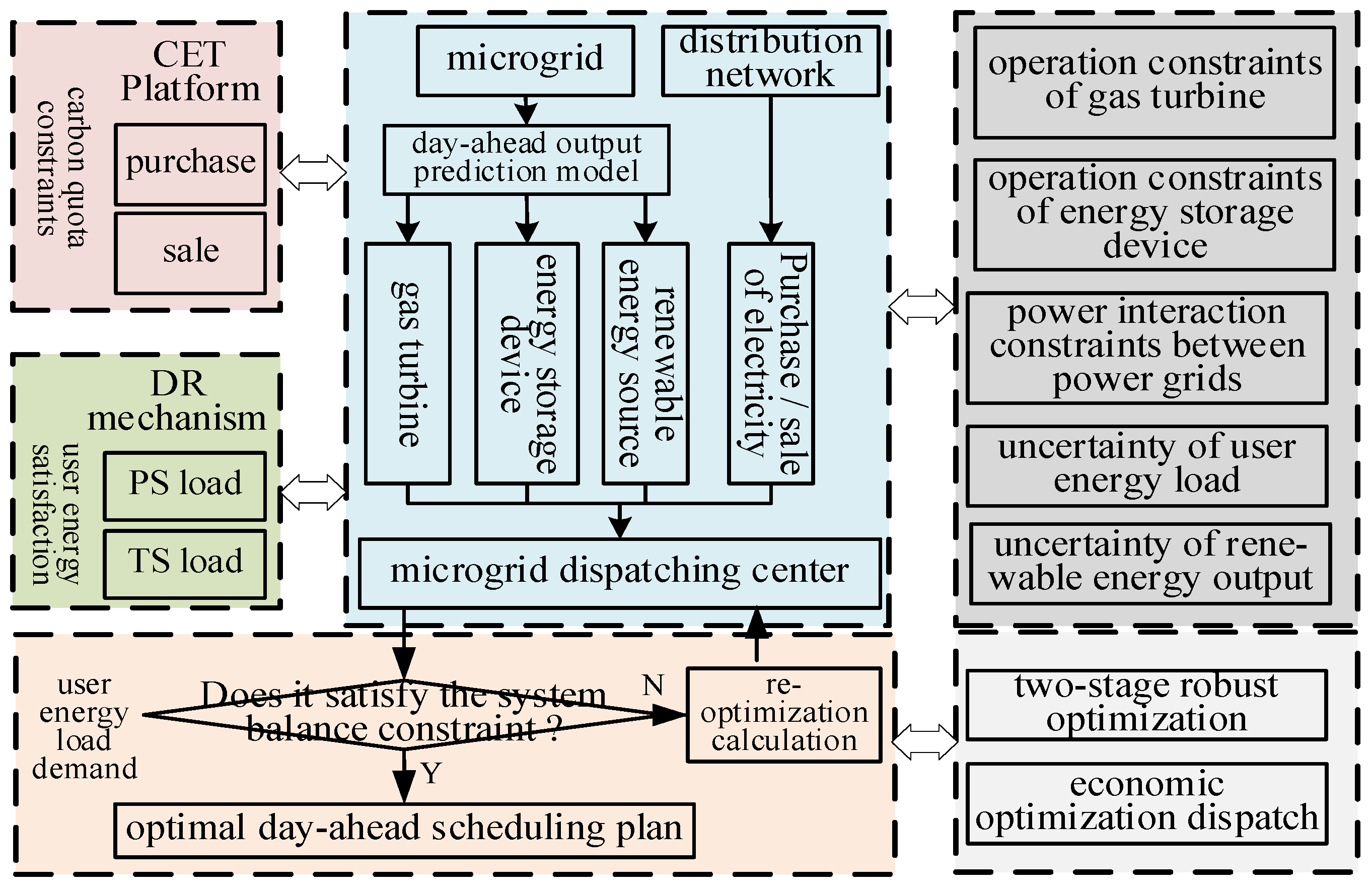

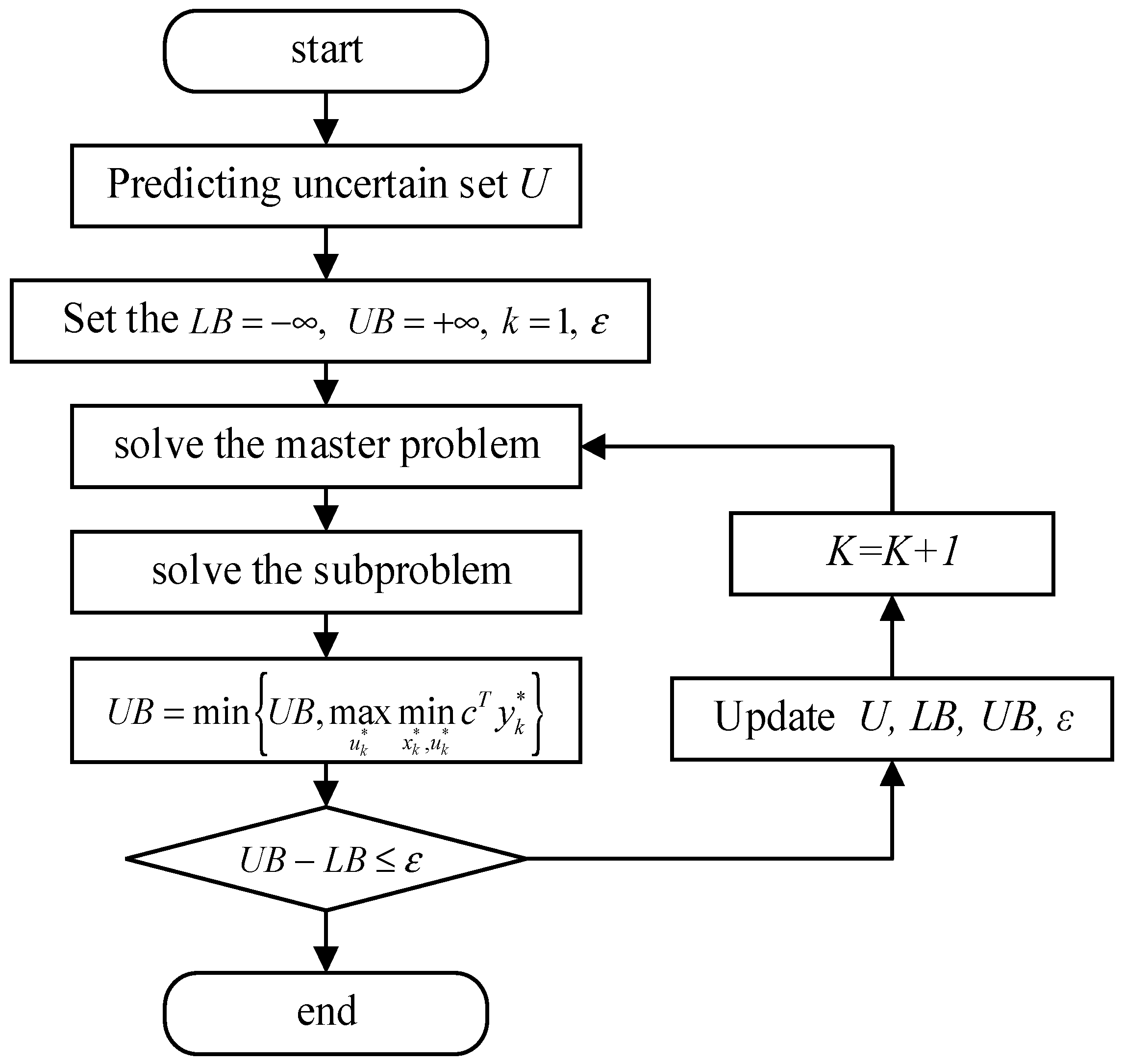

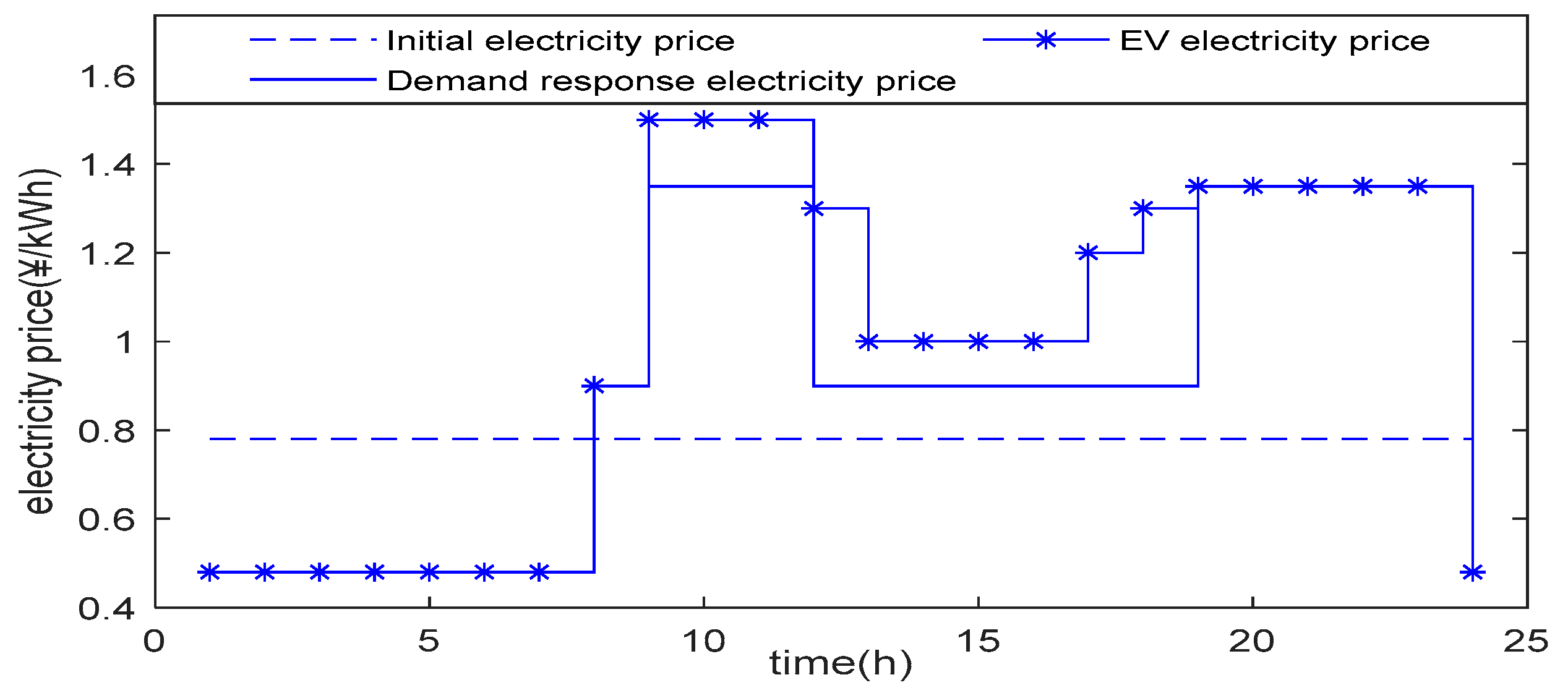
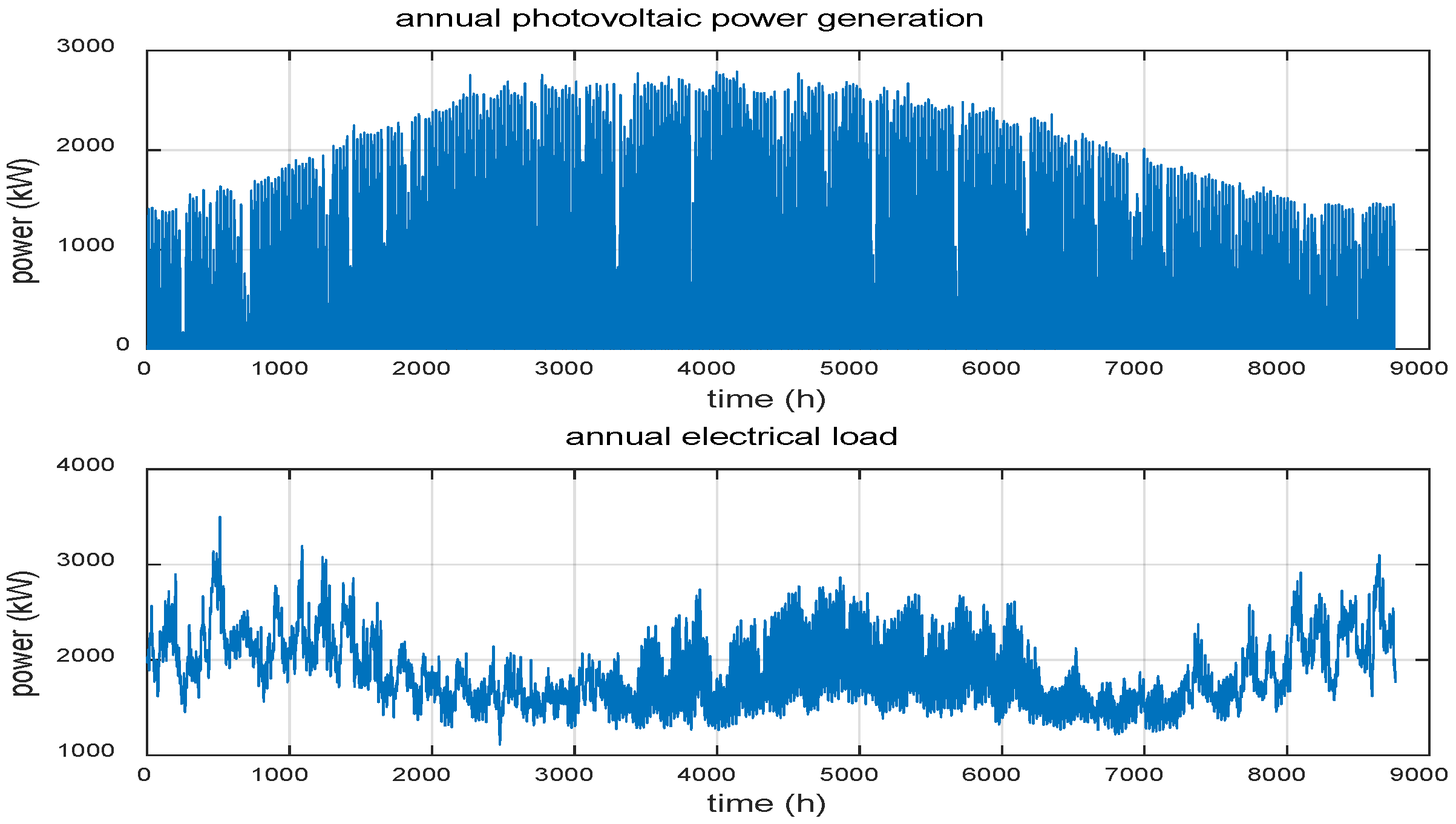



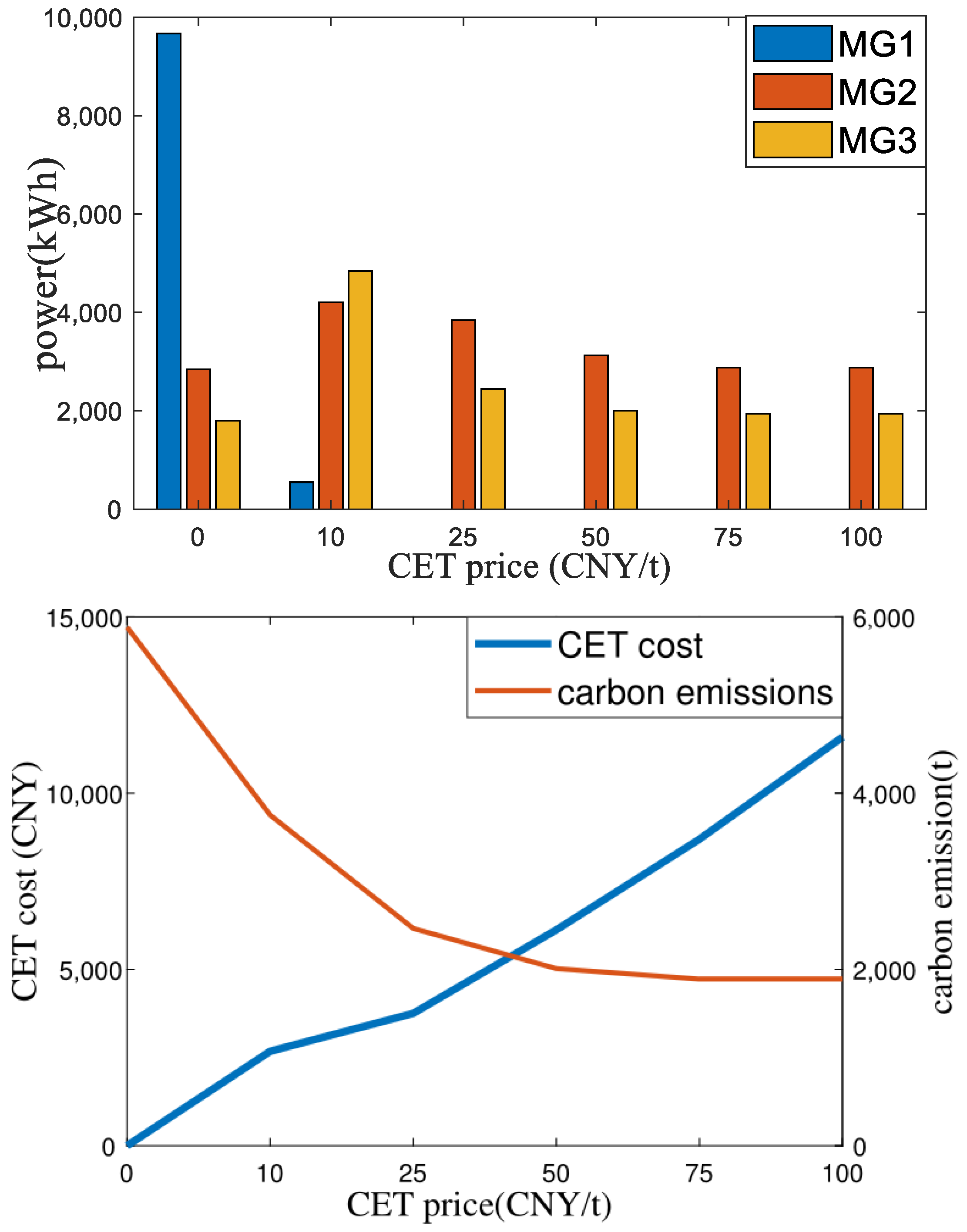

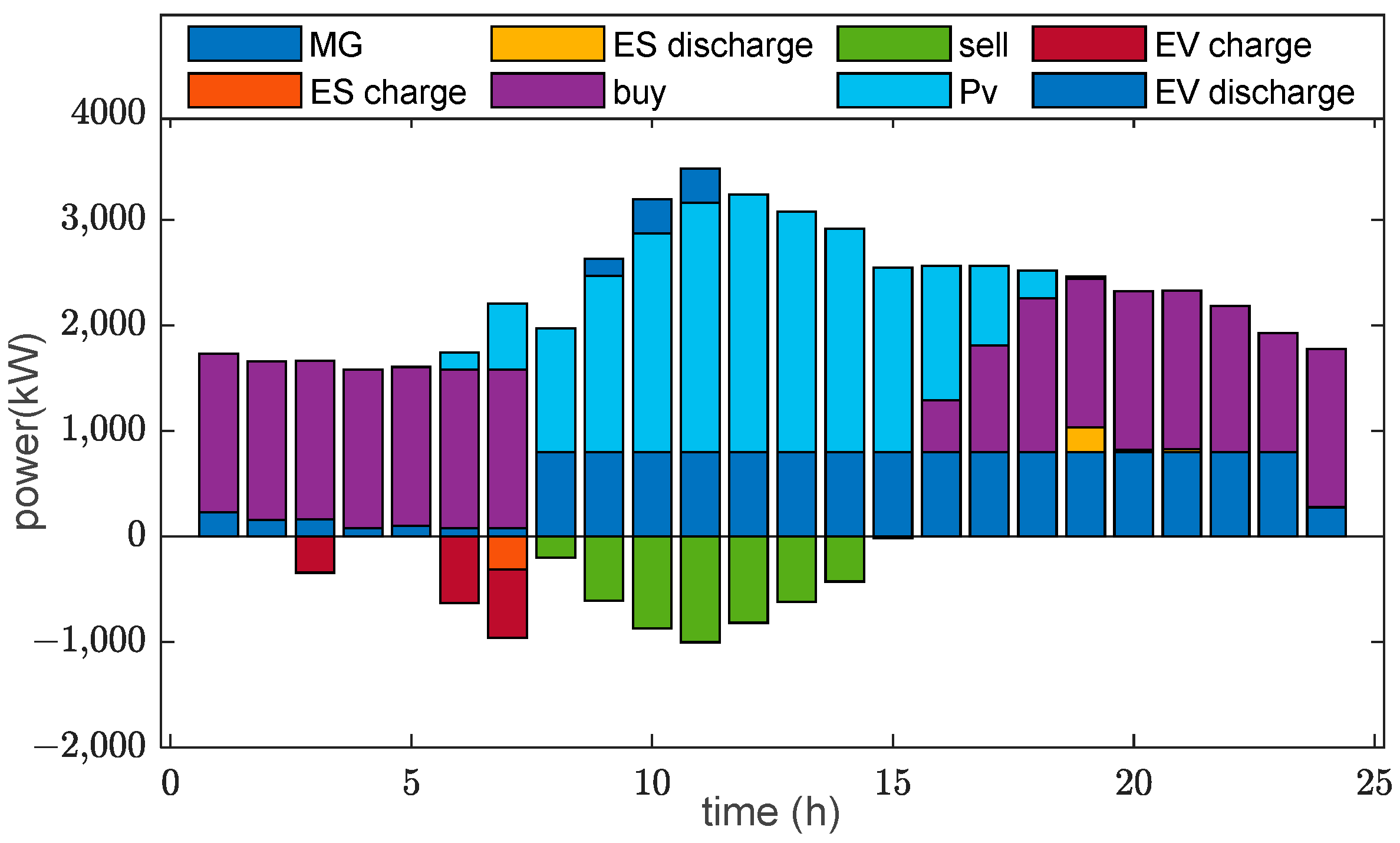
| Unit | Parameters | Value |
|---|---|---|
| MG1 | 500 | |
| 80 | ||
| 0.67/0 | ||
| 0.42/0.35 | ||
| MG2 | 200 | |
| 80 | ||
| 0.67/0 | ||
| / | 0.4/0.38 | |
| MG3 | 400 | |
| 80 | ||
| 0.67/0 | ||
| 0.36/0.35 | ||
| PV | 0.3/0 | |
| ESS | 500 | |
| 1800 | ||
| 400 | ||
| 1000 | ||
| 0.38 | ||
| 0.95 | ||
| DR | 0.32 | |
| The power exchanged by the distribution network | 1500 |
| PV | Load | Cost |
|---|---|---|
| 8 | 13 | 33,970.69 |
| 5 | 12 | 33,452.06 |
| 4 | 12 | 33,395.6 |
| 4 | 10 | 32,811.31 |
| 0 | 0 | 30,565.19 |
Disclaimer/Publisher’s Note: The statements, opinions and data contained in all publications are solely those of the individual author(s) and contributor(s) and not of MDPI and/or the editor(s). MDPI and/or the editor(s) disclaim responsibility for any injury to people or property resulting from any ideas, methods, instructions or products referred to in the content. |
© 2023 by the authors. Licensee MDPI, Basel, Switzerland. This article is an open access article distributed under the terms and conditions of the Creative Commons Attribution (CC BY) license (https://creativecommons.org/licenses/by/4.0/).
Share and Cite
Zhang, Y.; Lan, T.; Hu, W. A Two-Stage Robust Optimization Microgrid Model Considering Carbon Trading and Demand Response. Sustainability 2023, 15, 14592. https://doi.org/10.3390/su151914592
Zhang Y, Lan T, Hu W. A Two-Stage Robust Optimization Microgrid Model Considering Carbon Trading and Demand Response. Sustainability. 2023; 15(19):14592. https://doi.org/10.3390/su151914592
Chicago/Turabian StyleZhang, Yi, Tian Lan, and Wei Hu. 2023. "A Two-Stage Robust Optimization Microgrid Model Considering Carbon Trading and Demand Response" Sustainability 15, no. 19: 14592. https://doi.org/10.3390/su151914592





